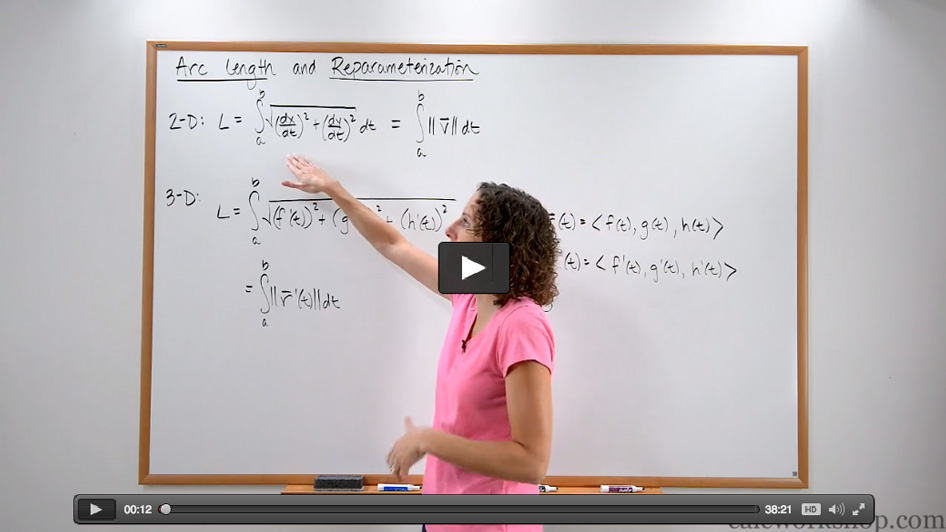What is arc length parameterization?

Jenn, Founder Calcworkshop®, 15+ Years Experience (Licensed & Certified Teacher)
Sounds complicated? But is it?
Let’s find out…
Arc Length Formula
Did you know that the arc length formula from single-variable calculus can be transformed into a function of time?
It’s true!
We recall that if \(f\) is a smooth curve and \(f^{\prime}\) is continuous on the closed interval [a,b], then the length of the curve is found by the following Arc Length Formula:
\begin{equation}
L=\int_{a}^{b} \sqrt{1+\left(f^{\prime}(x)\right)^{2}} d x
\end{equation}
Arc Length Of A Parametric Curve
But as we discovered in single variable calculus, this integral is often challenging to compute algebraically and must be approximated.
Thankfully, we have another valuable form for arc length when the curve is defined parametrically. We will use this parameterized form to transform our vector valued function into a function of time.
Recall that if \(\vec{r}=\langle x, y\rangle\) or \(\vec{r}=\langle x, y, z\rangle\), the length of the curve on the closed interval [a,b] is:
\begin{equation}
\int_{a}^{b}|| \vec{r}^{\prime}(t)|| d t=\int_{a}^{b} \sqrt{\left(x^{\prime}\right)^{2}+\left(y^{\prime}\right)^{2}} d t \quad \text { or } \quad \int_{a}^{b}|| \vec{r}^{\prime}(t)|| d t=\int_{a}^{b} \sqrt{\left(x^{\prime}\right)^{2}+\left(y^{\prime}\right)^{2}+\left(z^{\prime}\right)^{2}} d t
\end{equation}
Position
Well, we can turn the familiar formula for the length of a curve into a function \(s(t)\) that measures how far an object or particle travels from \(\vec{r}(a)\) at time \(t\) by replacing \(b\) with \(t\) and using another variable other than \(t\), like \(\tau\), so that we get:
\begin{equation}
s(t)=\int_{a}^{t}|| \vec{r}^{\prime}(\tau)|| d \tau \quad \text { or } \quad s(t)=\int_{a}^{t} \sqrt{\left(x^{\prime}\right)^{2}+\left(y^{\prime}\right)^{2}+\left(z^{\prime}\right)^{2}} d \tau
\end{equation}
This transformation is called arc length reparameterization or parameterization.
And the most useful application of the arc length parameterization is that a vector function \(\vec{r}(t)\) gives the position of a point in terms of the parameter \(t\).
Assuming \(s\) is the distance along the curve from a fixed starting point, and if we use \(s\) for the variable, then \(\vec{r}(s)\) is the position in space in terms of the distance along the curve.
In other words, as Paul’s Online Notes so nicely states, with parameterization, we can find the position of an object as a function of how far it traveled.
Example – How To Find Arc Length Parametrization
Let’s look at an example.
Reparametrize \(\vec{r}(t)=\langle 3 \cos 2 t, 3 \sin 2 t, 2 t\rangle\) by its arc length starting from the fixed point \((3,0,0)\), and use this information to determine the position after traveling \(\pi \sqrt{40}\) units.
First, we need to determine our value of \(t\) by setting each component function equal to the fixed point.
\begin{equation}
\langle\underbrace{3 \cos 2 t}_{x}, \underbrace{3 \sin 2 t}_{y}, \underbrace{2 t}_{z}\rangle \text { and }(\underbrace{3}_{x}, \underbrace{0}_{y} \underbrace{0}_{z})
\end{equation}\begin{equation}
\begin{array}{ccc}
3 \cos 2 t=3 & 3 \sin 2 t=0 & 2 t=0 \\
\cos 2 t=1 & \sin 2 t=0 & t=0 \\
t=0 & t=0 &
\end{array}
\end{equation}So, our initial value is \(t=0\), which can be easily verified when substituted in our vector-valued function:
\begin{equation}
\vec{r}(0)=\langle 3 \cos 2(0), 3 \sin 2(0), 2(0)\rangle=\langle 3,0,0\rangle
\end{equation}Next, we need to find \(\vec{r}^{\prime}(t)\).
\begin{equation}
\begin{aligned}
&\vec{r}(t)=\langle 3 \cos 2 t, 3 \sin 2 t, 2 t\rangle \\
&\vec{r}^{\prime}(t)=\langle-6 \sin 2 t, 6 \cos 2 t, 2\rangle
\end{aligned}
\end{equation}Now we substitute into our arc length parameterization formula, simplify and integrate.
\begin{equation}
\begin{aligned}
&s(t)=\int_{a}^{t}|| r^{\prime}(\tau)|| d \tau=\int_{a}^{t} \sqrt{\left(x^{\prime}\right)^{2}+\left(y^{\prime}\right)^{2}+\left(z^{\prime}\right)^{2}} d \tau \\
&s(t)=\int_{0}^{t} \sqrt{(-6 \sin 2 t)^{2}+(6 \cos 2 t)^{2}+(2)^{2}} d \tau \\
&s(t)=\int_{0}^{t} \sqrt{36 \sin ^{2}(2 t)+36 \cos ^{2}(2 t)+4} d \tau \\
&s(t)=\int_{0}^{t} \sqrt{36\left(\sin ^{2}(2 t)+\cos ^{2}(2 t)\right)+4} d \tau \\
&s(t)=\int_{0}^{t} \sqrt{36+4} d \tau \\
&s(t)=\int_{0}^{t} \sqrt{40} d \tau \\
&s(t)=t \sqrt{40}
\end{aligned}
\end{equation}Now, we will solve for \(t\).
\begin{equation}
t=\frac{s(t)}{\sqrt{40}}
\end{equation}Next, we will plug \(t\) into our \(\vec{r}(t)=\langle 3 \cos 2 t, 3 \sin 2 t, 2 t\rangle\) function and simplify to get our reparametrized solution:
\begin{equation}
\begin{aligned}
&\vec{r}(t)=\left\langle 3 \cos 2\left(\frac{s(t)}{\sqrt{40}}\right), 3 \sin 2\left(\frac{s(t)}{\sqrt{40}}\right), 2\left(\frac{s(t)}{\sqrt{40}}\right)\right\rangle \\
&\vec{r}(t)=\left\langle 3 \cos \left(\frac{2 s}{\sqrt{40}}\right), 3 \sin \left(\frac{2 s}{\sqrt{40}}\right), \frac{2 s}{\sqrt{40}}\right\rangle
\end{aligned}
\end{equation}Lastly, we will use this reparametrized function to find the position in space in terms of the distance along the curve after the object has traveled \(\pi \sqrt{40}\) units.
\begin{equation}
\begin{aligned}
&\vec{r}(\pi \sqrt{40})=\left\langle 3 \cos \left(\frac{2(\pi \sqrt{40})}{\sqrt{40}}\right), 3 \sin \left(\frac{2(\pi \sqrt{40})}{\sqrt{40}}\right), \frac{2(\pi \sqrt{40})}{\sqrt{40}}\right\rangle \\
&\vec{r}(\pi \sqrt{40})=\langle 3 \cos (2 \pi), 3 \sin (2 \pi), 2 \pi\rangle \\
&\vec{r}(\pi \sqrt{40})=\langle 3,0,2 \pi\rangle
\end{aligned}
\end{equation}
And that’s it.
Don’t worry. We’ll walk through more challenging problems in the following video, and I’m confident you’ll get the hang of things really quickly!
So, let’s jump right in!
Video Tutorial w/ Full Lesson & Detailed Examples (Video)

Get access to all the courses and over 450 HD videos with your subscription
Monthly and Yearly Plans Available
Still wondering if CalcWorkshop is right for you?
Take a Tour and find out how a membership can take the struggle out of learning math.